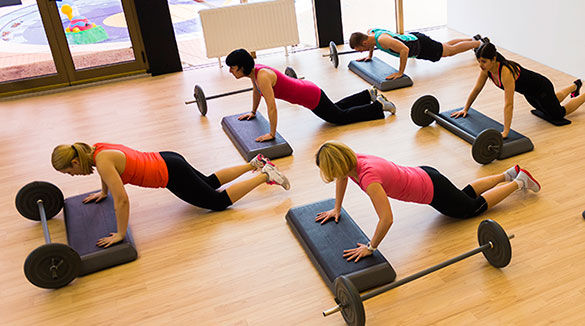
If you’ve been teaching fitness classes for a decade or more, chances are you taught step along the way. What about now? Are you teaching as many step classes as in the past? Or any at all? You might still love step, but perhaps you’ve moved on to other formats, either because you no longer have the time or inclination to create and rehearse all that fancy choreography, or the club where you teach doesn’t offer many opportunities for step instruction.
You might still use the step, but it’s in classes that don’t actually include the word “step” in the title! Traditional, choreographed step has largely taken a backseat to other formats. But will it stay that way? Do we want to revive traditional step, or are we better off adapting it for today’s progressive programming?
How Is Step Faring in Today’s Group Exercise Climate?
Think back to the group exercise culture of 10 or 20 years ago: Step ruled most group-exercise schedules. Step classes were among the most popular and almost always at primetime. The more choreographed the step workout, the better.
And now? Most facilities still own steps—and they do get used—but the culture has shifted. Choreographed step classes are less common. In today’s programming, steps are more often positioned as a versatile fitness tool versus celebrated as the workout’s main attraction.
Lauren Rogers is the Manager of Fitness and Wellness at the University of New Brunswick in Fredericton, New Brunswick, where she programs group exercise for the university’s students, faculty and staff. Of the 26 weekly fitness classes on the schedule there, she reports that only one is a step class (scheduled during the lunch hour). “We did offer a second step class in the evening, but did not continue it [with the new schedule] due to low participation,” says Rogers.
The story is similar elsewhere. Of the eight group exercise programs that Julie Miller of South Windsor, Conn., manages as Group Exercise Promotional Director for Club Fitness, only half—four of the eight locations—offer any type of step class.
Based in Boulder, Colo., Shannon Fable is the Director of Exercise Programming at Anytime Fitness and the owner of GroupExPRO.com, a web-based communication portal for group fitness programs. She sees an interest in choreographed classes coming mainly from those patrons who’ve already been doing it for years. “In the last group-exercise program I managed, there was one step class on the schedule,” says Fable. “It was poorly attended, but the same crew of women who had taken step classes since its inception demanded to have it on the schedule.”
Why the Sliding Interest in Step?
Is it that step simply had its heyday and now it’s time for the fitness industry to move on? Maybe, but there are still plenty of step fans out there. “After all these years, step is still my favorite class to teach,” says Rogers.
In general, step is experiencing an industry-wide slow-down that it might never recover from. Is it due to lack of interest from instructors, or lack of interest from group participants? Likely, it’s a bit of both.
For one thing, a lot of fitness participants who didn’t first learn step choreography and step terminology back in the heyday are now lost. The scarcity of traditional step means no more beginning step classes.
Compared to a lot of other group formats, traditional, choreographed step classes have a steep learning curve for everyone. “Learning the movements of the step, the language (each instructor has his or her individual language) and timing of the music takes a significant amount of time and practice,” says Rogers. “In the past, it was more acceptable for new instructors to begin teaching before their skills were perfected. Group fitness participants now expect new instructors to be refined in their skills.”
“There’s no easy on-ramp,” adds Fable. “It’s hard to jump in and compete with folks that have been teaching step forever. The folks who still take step classes demand the choreography, which is hard to learn.” And there are fewer workshops and trainings these days that guide newer instructors through the process of teaching this format. You either know how to break down, perform and cue an over-the-top-syncopated-shuffle-double-knee-repeater-reverse-turn … or you don’t.
Comparatively, other freestyle classes that compete with step—such as boot camps, strength classes and athletic-style workouts—require far less prep time and little or no choreography/exercise-to-music skills. That makes it easier, potentially less stressful and vastly less time-consuming for instructors to prepare and teach.
Miller also points out that the enormous popularity of branded fitness programs today may have an impact. Step is not a highly developed and polished brand like other programs it must compete with, such as Zumba and Les Mills.
With traditional, freestyle step, there just isn’t the brand support, says Miller, who has a background in managing corporate and commercial fitness clubs and has been teaching group fitness for 30 years. “Formats marketed on TV (like Zumba, P90X and others) also now have certifications.” Many new instructors are drawn to these “proven formulas” in group exercise, with their already established popularity, prepared programming/choreography and provided music.
Finally, entry points into the fitness industry might also be contributing to the decline in traditional step’s popularity. “I think fewer fitness professionals in general are becoming exercise-to-music instructors,” says Anneke van Alderwegen, M.A., a fitness instructor whose background includes 15 years of experience managing group exercise in public and private fitness organizations in Victoria, British Columbia. “Ten or more years ago, group fitness was one of the only paths to becoming a fitness leader, so instructors got the training and then, perhaps, later on specialized in strength or went on to personal training.” Now, personal training is a career path on its own.
Keeping Step Alive in Group Exercise
“I never see it going away,” says Miller, “but I do see it being sporadic within group class program offerings.”
“As far as step making a major comeback, I doubt that it will ever regain the popularity it once had,” says van Alderwegen. “When step first came out, it was one of the only ‘different’ kinds of classes available. Now there are so many options.”

The highly choreographed step format might be dying out, but, as Rogers points out, the equipment is still with us: “I believe that every fitness program will continue to store steps and risers in their equipment rooms due to the step’s diversity.”
With the knowledge, skills, creativity and equipment we have in the fitness industry today, the step—as a piece of group equipment—provides a new level of exciting versatility that we can adapt to many of today’s progressive formats. Even if the traditional step class of the past fades away, a new simple, athletic style has already begun to emerge, observes Rogers.
Most fitness facilities store stacks of steps and risers in their group exercise studios, indicating that the step is still one of the industry’s most accessible and adaptable tools. Here are some ideas for re-igniting step usage in your current group programming:
- Bring out the step in classes that use a variety of equipment, training techniques and/or styles. Steps work well in multiformat cardio classes with names such as Cross Train, Interval Training, Athletic Training, Boot Camp, Cardio Mix, etc.
- Use the step as a strength, core or plyometric tool, setting it up either horizontally or vertically. For strength and core classes, remember that you can make it higher than you would in a cardio class, using more risers. Or, set it up as an incline or decline bench.
- Introduce basic step classes for beginners and/or older-adult classes, where there is no expectation that the choreography will become complex.
- Introduce intense, choreography-free interval or plyometric step classes without any emphasis on having to step up and down on the beat.
Step is not dead; it’s just changing. “Fitness facilities need to think about how to make these classes approachable and not intimidating so that this enjoyable, fun kind of fitness class does not disappear!” says van Alderwegen.





 by
by 



